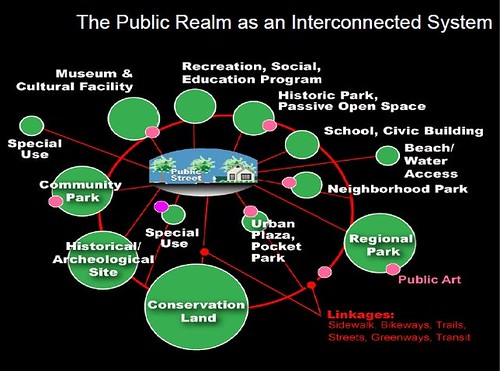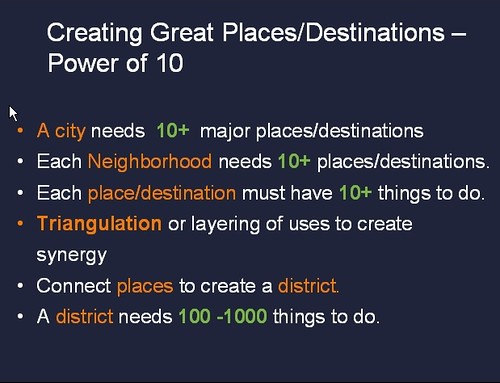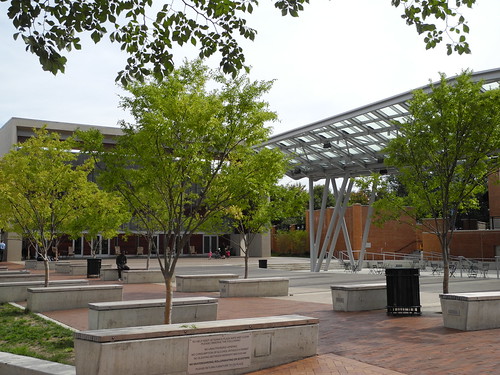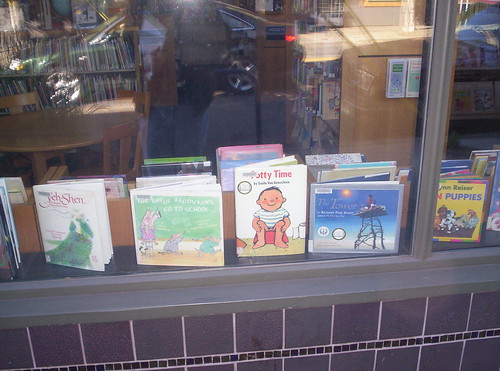The layering effect: how the building blocks of an integrated public realm set the stage for community building and Silver Spring, Maryland as an example
In the earlier part of the last decade I got pretty interested in the work of the organization Project for Public Spaces, which grew out of the work of Jane Jacobs and William Whyte, although the organization remained independent of either.
In 2005 there was a great article in Governing Magazine, "Pride of Place: Fred Kent and the Project for Public Spaces," about their work. Fred Kent, the president of PPS, is particularly good at explaining the simplicity at the core of complexity. The article discusses "layering" and how key improvements anchor and support further changes.
So layering is a good concept to have in your urban revitalization arsenal of tools and tactics, along with an understanding of the value of anchors or assets that attract people and generate activity, such as a parklet or library or plaza, or a coffee shop or community center of some type (in the DC area, Bloombars in Columbia Heights, Electrik Maid in Takoma DC, or the Corner Store in Capitol Hill do this at various levels of success).
And the best way to think about this is in terms of the David Barth concept of the integrated public realm framework (slide, below).

If we think of layering as a site or more micro- concept, then the integrated public realm framework is layering "writ large" at the larger scale of a neighborhood, commercial district, or town center.
The basic concept is to have the right kinds of assets, assets that can be flexibly used, satisfy multiple kinds of uses, that can be "manipulated" in a variety of ways by a variety of types of groups, and that are integrated as a kind of network.
PPS calls this type of integration--assets + programming--the Power of 10.

Slide, Project for Public Spaces.
Anchor spaces
The Silver Spring Veterans Plaza and Civic Building is a perfect example of creating a flexible civic asset. It anchors public activity and the public realm framework in Downtown Silver Spring, in the context of otherwise almost completely commercially owned space.

Veterans' Plaza by tracktwentynine, on Flickr.
Design matters: anchor spaces need to be flexible, not overdesigned
The Plaza is a multipurpose space. It has benches. It has a sunken bowl plaza. It has an overhanging roof over part of the structure. It has a little building that supports ice rink functions in the winter. They provide movable tables and chairs, and lounge chairs (wooden) in front of the Civic Building. The space isn't so overly designed that it can't be used.

Spaces also need to be programmatically flexible, not just physically flexible
The Fenton Street Market, on Saturdays, is a flea market, that was originally in a forlorn location about 0.75 miles away, further south, not proximate to other civic activities, and not having a lot of power in terms of strengthening place value.
High rental fees and permit requirements forced the temporary closure of the Fenton Street Market there, because the "revenue" from vendor fees didn't come close to paying the required fees. See the past blog entry, "Two sides of the same coin: how to support community events in the face of high charges for permits etc.?"
It took awhile, but Montgomery County figured out sort of that Veterans Plaza shouldn't just be seen as a space to monetize, but as a space that can make place.
After that was "rectified," you can see how the space has become supra-activated, because flexibility is built into the space in terms of it not being over designed and specified.

Anchor spaces enable anchor activities, but good management is key
Just because you have activities like a flea market doesn't mean that they will be well managed and have the desired effect.
There are plenty of flea markets and such around the area that are pretty grim.
And there are plenty of seemingly successful places that don't truly provide a great experience.
The Fenton Street Market is more purposeful in how they manage the mix of the activities and attractions so that the Market has a lot going on at any one time, programming the space beyond just offering vendors, with other simultaneous activities, ranging from all-ages beading classes to "concerts" by high school bands.
I haven't talked with the proprietor of the market, so I don't know how they figured this out, but it is in line with how I suggest that commercial districts plan their retail, attraction, and event mix purposefully, by demographic and daypart, to achieve maximum use and vitality.
But it's not like the only use of the space is by the Fenton Street Market on Saturdays. (See "Fenton Street Market in Silver Spring seeing increase in patrons this season" from the Gazette.)
During the week people use the space on their own, for gathering, sitting at movable tables and chairs, and people organize and conduct various activities there, such as dance classes.
Multiplicative effects: the power of layering by building off anchor spaces and activities
Key civic and cultural assets in Silver Spring's public realm framework include:
- Ability to close Ellsworth Drive for public events
- Farmers Market on Ellsworth Drive
- Splash fountain on Ellsworth Drive
- Ability to use parking lot at Colesville Rd./Georgia Avenue when other activities on Ellsworth may displace the Farmers Market
- Veterans Plaza
- Veterans Plaza skating rink in winter
- Silver Spring Civic Building
- American Film Institute at Silver Theatre
- Fillmore Arts Center (a for profit entity)
- Round House Theatre
- Pyramid Atlantic Arts Center
- Montgomery [Community] College Silver Spring-Takoma Campus
But the addition of the Veterans Plaza as a civic space that provides for a variety of uses and the Fenton Street Market as a key activity anchor, now this area is becoming the center for street festivals (Ethiopian a few weeks ago, apparently it was packed; African this weekend, etc.) which develops new activities, introducing new audiences to the commercial district, and further strengthening the layering effect.

Ice skating on Veterans Plaza in winter.
Yes there have been some safety issues as the space becomes more popular and a destination ("Concerns about Silver Spring spur consideration of curfew" from the Washington Post) and in how some private companies manage the public use in what they treat as privately owned spaces ("Downtown Silver Spring Will Receive Breast-Feeding Education" from the LaLeche League and "Developer Can't Ban Photos, Leggett Says" from the Washington Post, and "Discovery HQ reopens garden after hostage situation" from Associated Press) but for the most part it works.
As Reemberto Rodriguez, director of the Silver Spring Regional Center for Montgomery County said, "when we first started out 80% of the activities here were programmed by the County, now it's 20%."
Above: some businesses contribute to the civic realm, such as how Ben & Jerry's puts a sandbox out in front of its store on Ellsworth Drive. And there is a doggy bathroom area supported by the Downtown Silver Spring businesses and a local pet shop.
A plaza isn't enough: Bethesda Row and Columbia Heights as counter examples

Bethesda Row fountain at Barnes & Noble. Flickr photo by North Bethesda Market.
While I am the first to argue that commerce is the engine of urbanism (a quote from Alex Wall), the reality is the community building is anchored by community spaces, and while you need spaces for informal gathering, you also need spaces for doing.
Plus the space, as discussed above, needs to be flexible and able to be programmed.
 While the little fountain space in front of the Barnes & Noble in Bethesda anchors Bethesda Row is now a community landmark and somewhat of a gathering place and there is a cool public plaza in Columbia Heights, anchored by a splash fountain and on Saturdays, a farmers market, neither space is complemented by more significant civic anchor spaces like the Silver Spring Civic Building, where other informal and formal community uses can take place.
While the little fountain space in front of the Barnes & Noble in Bethesda anchors Bethesda Row is now a community landmark and somewhat of a gathering place and there is a cool public plaza in Columbia Heights, anchored by a splash fountain and on Saturdays, a farmers market, neither space is complemented by more significant civic anchor spaces like the Silver Spring Civic Building, where other informal and formal community uses can take place.Image: Columbia Heights (DC) Civic Plaza. Flickr photo by Otavio_DC.
Even though both places are pretty vibrant, these plazas aren't programmed quite in the same manner as the Silver Spring Veterans Plaza, although there is a farmers market at the space in Columbia Heights, and a nearby one in Bethesda. Plus the Bethesda location is at a kind of junction for the Capital Crescent Trail and down the street from the Landmark Cinemas.
See the blog entries, "Community cleanups and other activities as community building and civic engagement activities," which is somewhat misnamed as it discusses various types of spaces that support community building, and "Ground up (guerrilla) art #2: community halls and music (among other things)."
Silver Spring is becoming Montgomery County's premier public space
The ability to extend community building is lost in places like Bethesda and Columbia Heights, because the civic infrastructure/integrated public realm framework is incomplete.
By contrast, as Silver Spring moves more towards the PPS ideal of the "Power of 10" including the addition of a library soon to be constructed one block from the Civic Building and Plaza (and eventually service from the Purple Line light rail to this area), the Silver Spring "Downtown" is being repositioned as Montgomery County's premier social and gathering space.
(Rockville Town Center has more opportunity to be a gathering place than Bethesda, it has the public assets like the library and VisArts to complement the small plaza there. But the plaza is small, albeit with a gazebo like presentation space, and not capable of supporting the wide array of events that can be supported in Downtown Silver Spring.)
Silver Spring isn't perfect: #1: Extending and integrating the network of civic spaces throughout Silver Spring
Other civic spaces--publicly or privately owned--in Silver Spring need to be integrated into this framework better than they are currently, ranging from the fake public space on the Discovery Channel block which is closed to the public and the otherwise mural adorned blank wall on Colesville Road, to the forthcoming transit center, which mostly looks like a parking garage, not a "train station," and other parklet spaces on private properties that are required by zoning approvals to be civic serving spaces open to the public. (Some of these spaces have similar issues to those in New York City, San Francisco, and DC. See "Private spaces as public spaces: legal rights of property owners vs. legal rights of citizens to use the space.)
#2: the Civic Building could be more civic and flexible internally
And the Civic Building could have been designed to be a little less governmental, with more flexible hours, and as a more definitive culture space, a bit more like BloomBars and the cultural centers attached to some of the libraries in Montreal, with spaces that are a bit more supportive of funky, or to have a more defined and apparent cultural function. Maybe even like the Chicago Cultural Center (but with better hours).
There is a gallery, but it's only open "government hours"--that is 9am to 5pm, Monday through Friday. The gallery has done art showings and presented traveling exhibits by organizations such as the Smithsonian Institution.
The pricing schedule for using space in the building is weighted, so that nonprofits and Montgomery County organizations pay less than for profits and non-County based organizations. And I think there is some provision for free use.
#3: The forthcoming Library will be a great amenity but probably could be even better
Silver Spring's public realm framework will be extended through the addition of a library at Fenton Street and Wayne Avenue, a block from the Civic Building and Veterans Plaza. It will be interesting to see how the Library space will be programmed.
Hours. Since the library will be located in a prominent downtown location, ideally the library should have extended hours, open beyond the normal 9pm closing time during the week at a minimum, and maybe more hours on weekends too, like I've argued for DC's central library, the Martin Luther King Junior Library downtown.
That's extremely unlikely. MoCo is still MoCo. I have to admit that I don't know of any local government public library systems with a library branch open past 9pm. But the state ("nationale") library of Quebec in Montreal, which also serves as the central library for the city, is open late, til 10pm, Tuesday through Friday.
Montgomery County could set national best practice by having extended hours at this location. [Note that since this written, in 2016, MoCo libraries in certain town centers such as Silver Spring are open began extending hours in the summer, til 9pm on Friday AND Saturday. See the library press release, "Montgomery County Public Libraries Add Hours at Five Branches."]
Functional program. But think of a "downtown" in this case a suburban downtown library designed and programmed to be more like a combination bookstore-student union, like the Athenaeum at Goucher College, which has ">an art gallery, a restaurant, and open forum space that can seat at least 700 people, and treadmills, exercise bikes, and rowing machines as well is a model for how libraries can be community and cultural centers (and recreation centers can be community centers). Granted, some of these functions are already provided by the Silver Spring Civic Building.
See "Is It a Library? A Student Center? The Athenaeum Opens at Goucher," in the Chronicle of Higher Education. (Note that in DC, the complex built and open in Deanwood has some of these aspects. I don't know how well it's programmed.)
Culture-History. In a piece about cultural planning in DC, I argue that we should combine visitor, city museum, and library functions into a new Central Library. ("Central Library Planning efforts and the City Museum, how about some learning from Augusta, Maine ... and Baltimore?")
Montgomery County could consider planning on this scale for the libraries in the key town centers (Bethesda, Silver Spring, Rockville, and Wheaton). The libraries could deliver cultural-historical functions, not unlike how the Peabody Room on local history in the Georgetown Branch of the DC Public Library system, and the system of Maisons de la Culture in Montreal (there are 14 cultural centers throughout the city, some are co-located with libraries, some are not).

Commerce. While there are already plans for a cafe, to support commerce and culture simultaneously, and flea market type functions, a portion of the outside structure could be built to accommodate bookseller stalls (L'Allée des bouquinistes), as it is done at the Bibliothèque Nationale de Quebec. (It's really cool.) Image from Spacing Montreal.
Note that the library in the Willesden District in London rents space to a local shop, the Willesden Bookshop, that otherwise couldn't afford to pay market rates.
In The New York Review of Books piece "The North West London Blues," Zadie Smith describes how the Willesden Green functions similarly to the Veterans Plaza area of Silver Spring, although the plaza will be replaced with a privatized housing condominium project and the bookstore eliminated. Also see "The Willesden Bookshop that inspired Zadie Smith faces closure: 'Heartbreaking' final chapter for independent bookseller White Teeth author praised for its service to its community" from the Guardian.
 Some libraries, such as the main Carnegie Library in Pittsburgh incorporate used book sales and gift shop functions, in addition to cafe functions.
Some libraries, such as the main Carnegie Library in Pittsburgh incorporate used book sales and gift shop functions, in addition to cafe functions. Right: the Northwest Public Library in the Nob Hill district of Portland Oregon leverages its location by "merchandising" its "store"front windows like a retail business.
Urban design. If such functions were offered at the Silver Spring library, they should be located on the exterior of the library and be designed to strengthen the streetscape at the ground level. The design in the current renderings doesn't read properly from the ground floor, in terms of traditional urban design expectations of streetfronts in commercial districts.
Plus, while it's seemingly really cool to integrate the light rail station into the library, a big problem is how loud the chimes for light rail trains tend to be (at least with Bombardier trains such as those in Minneapolis) when the train leaves the station. That level of repetitive noise isn't a good thing for libraries.
Conclusion
In all likelihood, while the Silver Spring Library will end up as a straight up library, it will extend the public realm.
But just as the broader network of public spaces and assets need to be planned for in a systematic way, just think how a good thing could be so much greater, if the planning concepts of the integrated public realm framework and layering were at the foundation of sector-commercial district revitalization-neighborhood revitalization planning, in Montgomery County and elsewhere.
Labels: arts-culture, commercial district revitalization, community building, community organizing, libraries, participatory democracy and empowered participation, public realm framework, urban design/placemaking







2 Comments:
Wichita has final fridays, but artists are looking to move it to first friday because of how last friday of the month conflicts with Halloween, Thanksgiving, and Christmas.
https://www.kansas.com/entertainment/ent-columns-blogs/keeper-of-the-plans/article225548380.html
2/11/2019
The Bentway in Toronto, is a "low line" under the Gardiner Expressway. It is a public space, activation reworking of the space and a model.
It could be a way to connect to other civic assets in the area, which are not coordinated at present.
https://www.theglobeandmail.com/canada/toronto/article-the-bentway-turns-pavement-into-great-green-public-space/
The Bentway turns pavement into great, green public space
10/27/2023
Post a Comment
<< Home